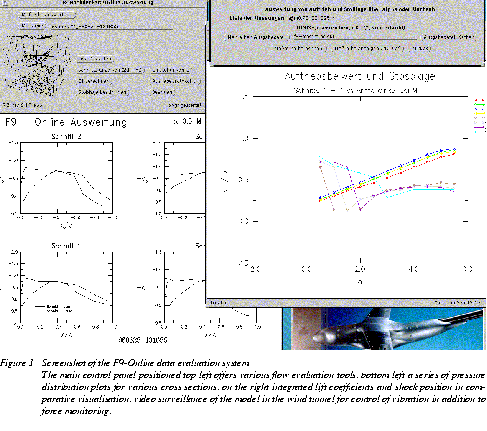Data acquisition and flow evaluation system
A necessary pre-requisite for advanced data evaluation of wind tunnel data is a modern, extendible and fast data acquisition system. The Transsonic Wind Tunnel at DLR in Göttingen is equipped with a modern data acquisition and control system named DeAs 1,2. One of the features of this system is an interface to add further measurement devices.
While such devices are usually data acquisition hardware or mechanical actuators they may as well be so-called virtual devices. Virtual devices are software running on the data acquisition computer which behave like ordinary devices, but make use of the data stream from the data acquisition system in some intelligent manner.
For the F9 experiments a virtual device was implemented which builds up a data communication to a second powerful workstation in the DLR network.

The virtual device selects a large subset of the measured data and supplies it to the data evaluation system. The selection of this subset is fast enough that it does not slow down the wind tunnel experiment. The actual flow evaluation and feature recognition process will then be performed in parallel on the second computer. The flow evaluation system was developed according to the special demands of the F9 experiments. But the system is highly modular which makes all components easily re-usable for further related applications. Therefor it will be used in a series of different experiments which are presently in the planning phase. Many modules were taken from a set of well tested tools developed earlier for flow analysis 5. Some modules and the graphical user interface were tailored towards the particular requirements of the F9-tests.
It is possible to re-configure the data evaluation system while the experiment is running without delay. Thus the desired data analysis may be selected on-the-fly from a suite of tools.
Data evaluation may be grouped in the following categories:
· dynamic pointwise supervision
· selection of sets of measured data for further analysissuch as visualization, comparison with previous sets or simulations.
· performance of feature detection process such as shock localisation.
· processing of series of sets of measured data according to common specifications.
The run-time flow evaluation of the F9-experiment allowed for the interactive evaluation and visualization of pressure distribution in various cross sections, the comparative visualization of such pressure distribution, numerical integration of cross section lift coefficients, determination of shock position, and comparative visualization of shock position across the wing span. Experience with shock detection and comparative visualization gained in earlier reseach 6, 7 were taken into account.
All these different post-processing tools may be selected interactively and the results are displayed graphically as shown in Figure 2. This visualization provides support for the wind tunnel crew to select parameters for the following sample.




